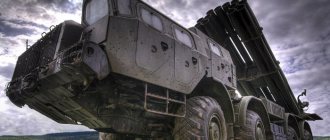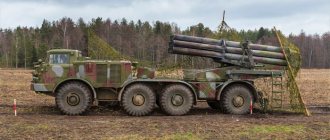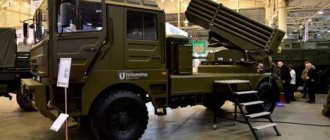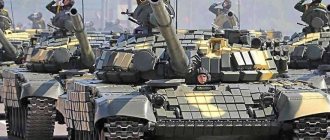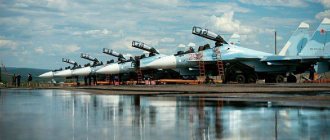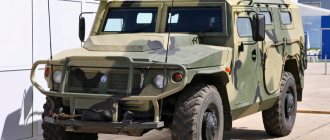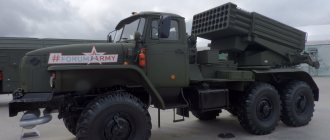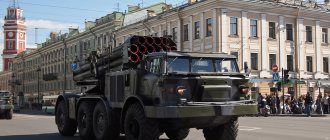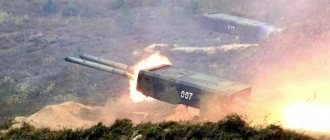The most common at present are the 122 mm BM-21 Grad installations produced in the former USSR and their derivatives and the American 227 mm MLRS system. They are either the ones most often involved in modern conflicts, or are actively sold and adopted into service. A steady trend has emerged: “We say MLRS – we introduce “Grad” / MLRS.” The creators of all kinds of computer “Civilizations”, Rise Of Nations and other similar strategies have been particularly successful in this. In fact, the world of MLRS is much richer and more diverse. Today we present to you rocket artillery vehicles, which, although they have not yet received such fame, are mass-produced and are in service.
Belarus
On May 9, 2015, the new Polonaise multiple launch rocket system was demonstrated at the Victory Day parade in Minsk. In August 2016, this system officially entered service with the Belarusian army, and since 2022 it has been exported to Azerbaijan. The Polonaise is considered one of the most effective types of weapons in Belarus. All elements of the Polonaise multiple launch rocket system are based on the MZKT-7930 Astrologer wheeled chassis. Such vehicles are actively used as a base for various weapons systems. The Polonaise fires Chinese 301mm A200 rockets. They have three different combat units. The missiles are fired according to the “fire and forget” principle; the trajectory is automatically adjusted using GPS.
MLRS "Polonaise", Belarus
Ukraine
The Ukrainian version of the Grad, the BM-21U Verba, was first demonstrated in November 2022. It has now been successfully tested and sent into mass production.
Features of “Verba” are the placement of the system on the basis of a KrAZ vehicle, full automation of all processes, the ability to control fire from the cabin, as well as the use of modern navigation equipment.
The combat vehicle's ammunition consists of 40 122-mm rockets, which are capable of destroying targets at a distance of up to 40 km. The transport-loading vehicle carries 80 rockets and is capable of replenishing ammunition or completely reloading a combat vehicle in a short time. Thanks to this, reloading a full package takes only 1 minute (seven times faster than on the Soviet BM-21 Grad).
MLRS "Verba", Ukraine
The use of digital fire control systems made it possible to reduce the time for opening fire on a target in unfamiliar terrain by 4 times (due to the automated calculation of firing data depending on topographic and meteorological conditions and aiming the warhead at the target), in addition, thanks to the new platform stabilization system, accuracy has increased significantly.
The launch vehicle is equipped with modern digital communication systems for secure transmission of information. In combination with the chassis of the KrAZ off-road vehicle, this provides the BM-21U Verba with increased combat effectiveness and mobility on the battlefield.
Brazilian RZO
Since the early 1960s. Brazil is developing MLRS systems for both the domestic and foreign markets. The first was the FGT-108RA1, which is now used by the Brazilian Armed Forces and Iraq. This MLRS fires a single-stage solid propellant 108 mm rocket from a 16-round launcher mounted either on the rear of a light vehicle or on a two-wheel trailer. The crew consists of 4 people, the battery has 4 MLRS. The X2A1 trailer used to mount the FGT-108 was also the base for the next system, the 36-round SBAT-70. She shoots a modified...
Read more
Egypt
This country, having received a significant number of BM-21 installations from the Soviet Union, subsequently modernized them with the participation of Western companies. These vehicles received the designation Sakr-30; they are distinguished by an increased firing range (up to 33 km) and an improved fire control system.
Having gained some experience, the Egyptians were able to create their own Sakr-36 MLRS. The launcher of this system has a package of 30 tubular guides of 122.4 mm caliber. An Isuzu all-terrain vehicle is used as the chassis.
A similar MLRS was created by the Egyptians based on the Soviet artillery tractor ATS-59G; it is designated Sakr-40.
MLRS Sakr-40, Egypt
Egyptian MLRS were supplied to Iraq.
In addition to tasks standard for rocket artillery, the Egyptians use multiple rocket launchers to set up smoke screens. In particular, D-3000 missiles launched from a vehicle developed on the basis of the Walid armored personnel carrier are used for this purpose.
Lightweight missile system LARS
The 110mm lightweight LARS rocket system was developed in the mid-1960s. and adopted by the Bundeswehr in 1969. It is supplied to the troops in the amount of one battery of 8 vehicles per army division, each battery has two Feldgard fire control systems on a truck chassis and an ammunition transport vehicle with 144 missiles. According to the modernization program to the LARS II standard, each launcher is now mounted on the rear of the chassis of a MAN 7-ton truck (6x6) and consists of two adjacent clips of 18 launch tubes. ...
Read more
Iran
The ground forces of the Islamic Republic of Iran, in addition to licensed and unlicensed copies of the Grad and the Chinese Type 63, are armed with the Fajr-3 and Fajr-5 long-range MLRS (Fajr means “dawn”). Produces them. Fajr-3 fires a 240 mm caliber projectile at a range of up to 43 km. The Japanese Isuzu truck was used as the chassis, then they began to use the Mersedes-Benz 2624, also with a 6 x 6 wheel arrangement, equipped with a more powerful engine. In the front part of the chassis there is a driver's and commander's cabin, behind it there is a combat crew cabin, in the aft there is a rotating platform with a package of four tubular guides.
MLRS "Fajr-3", Iran
The Fajr-3 MLRS uses 333 caliber ammunition at a range of 75 km. The layout is the same as the previous installation; two packages of six tubular guides are mounted on the turntable.
Iranian-made missiles are actively used by fighters of the Lebanese Shiite organization Hezbollah.
MLRS "Fajr-5", Iran
From “object 233” to “Katyusha”: design and development of the world’s best multiple launch rocket system
The development of mobile multiple launch rocket systems began at the secret Scientific Research Institute No. 3 (NII-3) of the USSR People's Commissariat of Ammunition. In December 1938, the first launcher with transverse rail guides for launching 24 RS-132 unguided rockets of 132 mm caliber was built and tested there on the ZIS-5 chassis. It turned out to be unsuccessful, but this did not stop it from becoming a prototype of future combat vehicles.
| The first missile system with transverse guides on the ZIS-5 truck. 1938 | |
The path to the legend: the first multiple launch rocket systems
At the end of the 1930s, the second experimental mechanized “auto-rocket” installation MU-1
volley fire. A longitudinal swinging frame with 24 transverse guides, arranged in two rows in a checkerboard pattern and used to launch 132-mm shells, was mounted on two welded racks on the frame of the car. Due to damage to the cabin by hot gases, strong rocking and poor accuracy of fire, this vehicle was also considered a failure.
| Experimental 24-charge launcher MU-1 on a ZIS-6 vehicle. December 1938 |
In August 1939, a more advanced MU-2
on a ZIS-6 chassis with a characteristic sloping rear part of the cabin.
It used longitudinal box-shaped guides with a package of eight rails, on which 16 missiles were attached. This option was considered quite acceptable and, in the process of testing and development, became the future BM-13
.
| Launching 132-mm shells from the MU-2 installation. September 1939 | Modified BM-13 launch system on the ZIS-6 chassis. 1940 |
By the fall of 1940, the institute had assembled six such installations, testing of which continued until mid-1941. At that time, they did not have a precise designation and were called “object 233,” an artillery system, a rocket-propelled grenade launcher, or a mechanized installation for launching RS-132 shells. Only in May 1941 were they assigned the well-known name “combat vehicle” and the index BM-13-16
(13 is the rounded caliber in centimeters, 16 is the number of shells).
| Battery of the first BM-13-16 combat vehicles with longitudinal guides. Autumn 1941 |
Legendary “Katyushas” during the Great Patriotic War
Rocket combat vehicle BM-13-16
On June 21, 1941, after successful tests, it was decided to urgently launch mass production of BM-13 vehicles on the 73-horsepower ZIS-6 chassis
. The war spurred this work, and soon several Soviet factories were engaged in assembling them, and at the same time they were actively creating batteries and divisions of jet combat vehicles, which during the war ordinary soldiers nicknamed “Katyushas”. By the end of the year, about 600 Katyushas of various types were assembled. Most of them died on the battlefield or were captured by the enemy, who unraveled the simple secrets of a fairly simple combat system.
| Launcher BM-13-16 from the first batch. Winter 1941–1942 (from the archives of J. Vollert) |
| One of the first serial combat systems BM-13 in the Staraya Russa area. August–September 1941 |
From a design point of view, the BM-13-16
wartime was an improved version of the pre-war model BM-13 and was also based on a modified ZIS-6 chassis with two rear folding screw jacks and a cabin with a beveled “rear” and a control panel on the front wall. To protect against the effects of rocket exhaust gases, steel armor plates stored on the cabin roof were lowered onto the front and side windows. On the open part of the platform there were seats for a combat crew of five to seven soldiers.
| The legendary BM-13-16 Katyusha missile combat vehicle, released in early 1942 (photo by the author) |
When hitting a target at a distance of up to 8.5 kilometers, each shell formed a crater in the ground with a diameter of eight meters and a depth of 1.5 meters. The curb weight of the BM-13-16 unit was 7.2 tons. The permissible speed is 40 km/h.
| Installation of the BM-13-16 on a ZIS-6 chassis with a sloping cab roof and an armor plate folded over it (photo by the author) |
| Serial "Katyusha" with longitudinal rail guides for launching rockets (photo by the author) |
A rotating metal truss with a package of eight channel guides was mounted on the frame of the car, on which eight lightweight 132-mm M-13 rockets were suspended from above and below. Targeting was provided by an artillery sight and the rotating and lifting mechanisms of the installation's warhead. To launch projectiles, there was a switch in the driver’s cabin that connected the battery with contacts for igniting the charges.
| Rear view of the artillery part of the BM-13 vehicle with 16 shells and two jacks (photo by the author) |
After the evacuation of the Moscow Automobile Plant in October 1941, production of ZIS-6 trucks was discontinued. The last BM-13-16 installations were assembled in the winter of 1942. Despite the stalemate, the outdated ZIS quickly found a worthy replacement in the form of more advanced vehicles supplied to the USSR under Lend-Lease. So, as a result, the American Studebaker US6 trucks unexpectedly became the base for the Russian Katyushas, on which the next combat vehicle BM-13N appeared in 1943, modifications of which were then produced until the 80s.
Soon after the war, dozens of monuments were erected to the legendary BM-13 Katyusha combat vehicle, beloved by veterans, but most of them were not true.
| The most reliable monument to “Katyusha” in the city of Rudnya, Smolensk region, erected in 1968 |
Until now, on the pedestals you can find non-existent angular front fenders and cabs without sloping rear ends, foreign headlights, wheels and tires, post-war two- and three-axle chassis and crude conversions of ZIS-5 trucks into ZIS-6.
BM-8 series missile launchers
In the most difficult conditions of the initial period of the war, NII-3 developed a light and compact launcher for aircraft, which served as the basis for the BM-8 multi-charge automotive multiple launch rocket systems with RS-82 (M-8) 82 mm caliber rockets. In July 1941, the first 38-round version of the BM-8-38
on an open ZIS-6 chassis. It was equipped with a turntable with a tubular-rail truss and a triple package of short guides with a different number of shells: 14 on the upper and 12 on the middle and lower tiers.
| Experimental 38-round BM-8-38 installation on a ZIS-6 chassis with an open cockpit. July 1941 |
On a more reliable, practical and lightweight 36-charge machine BM-8-36
, adopted for service in August 1941, the number of lower guides was reduced to ten. By November, 270 such installations had been assembled, but during the battles all were destroyed.
| The second 36-round sample BM-8-36 with 82 mm rockets. August 1941 (from the archives of M. Sokolov) |
In the spring of 1942, a new 48-round BM-8-48
with a beveled “rear” of the cabin and two packages of extended rail guides. Its combat weight was 5.5 tons. Together with the basic BM-13 installation, it became the second most important combat missile vehicle of the Great Patriotic War, although in the summer of the same year it was transferred to Lend-Lease chassis.
| Pre-production 48-round combat vehicle BM-8-48 on the ZIS-6 chassis. June 1942 (photo by the author) |
| Installation of BM-8-48 with two packages of rail guides and rear folding jacks (photo by the author) |
Other wartime vehicle-missile systems
At the height of the war, several domestic factories assembled small series of combat systems and original single copies on ordinary flatbed trucks, which did not have any impact on the course of the war. A fairly large batch of several dozen light BM-8-40
and
BM-8-60
were mounted on puny GAZ-AA/MM semi-trucks, which turned out to be too weak for a brutal war.
| The only image of a 40-round combat vehicle BM-8-40 based on a semi-truck. 1943 | Reconstruction of the BM-13 installation of the 1941 model, mounted on a later ZIS-5 chassis |
In the fall of 1941, a dozen and a half BM-13
on the serial three-ton ZIS-5, which turned out to be unsuitable for carrying heavy weapons. Detailed information and photographs of these machines have not been preserved.
| Installation KS-108 with launch tubes for projectiles with a range of up to 800 meters. 1942 |
In October 1942, a unique four-shot combat vehicle KS-108
on a ZIS-6 chassis, equipped with four smooth-bore tubular guides for firing 304 mm caliber rockets. Later, a prototype of a semi-armored installation with an artillery unit from the BM-13, which turned out to be too heavy, was assembled on the same chassis.
| An experimental vehicle with a BM-13 warhead and guidance and control systems from an armored cab. May 1944 |
At the final stage of the war, the ZIS-6 became the basis for the prototype of the BM-31-12
, but in March 1944 it was transferred to overseas Studebakers.
Serial "Katyushas" in peacetime
In the wake of the success of the military Katyushas, at military parades in the second half of the 1940s on Red Square, the well-known wartime multiple launch rocket systems BM-13N and BM-31-12, mounted on conventional ZIS-150
. The likely goal of creating 10–15 such systems was considered to be the rapid delivery of powerful weapons on public roads.
| ZIS-150 vehicles with BM-13N units on Manezhnaya Square before the parade in Moscow. 1947 |
| On Red Square, 12-round BM-31-12 missile systems are mounted on ZIS-150 trucks. 1948 |
At the end of the 1940s, the laurels of Victory that the Katyushas received during the war years were transferred to the new three-axle all-wheel drive truck ZIS-151
with armor protection of the cabin and gas tank. It served as the basis for both previous systems and new designs, which continued to be called “Katyushas”.
| Normalized installation of the BM-13N on the ZIS-151 chassis on display at the Warsaw Military Museum (photo by the author) |
The first of these was the normalized BM-13N
model 1943, adapted for serial production. After the war, its artillery unit was transferred to the ZIS-151 and in 1949 it was adopted by the Soviet Army under the designation 52-U-9416. Otherwise, it was no different from the first-born BM-13-16, but could fire several types of projectiles at a distance of 7.9–8.5 kilometers. Spare wheels, batteries, entrenching tools and spare parts boxes were placed on the metal flooring of the warhead. The permissible speed was 50 km/h.
| Restored BM-13N multiple launch rocket system on a ZIS-151 army truck (photo by the author) |
| BM-13N combat vehicle at an exhibition of military equipment in the Polish town of Skierniewice (photo by the author) |
The same fate awaited the powerful BM-31-12
with honeycomb guides for launching 12 310 mm caliber rockets, originally mounted on an American chassis.
| BM-31-12 multiple launch rocket system, model 1949, with honeycomb guides (from the archive of E. Pevzner) |
| Combat installation BM-31-12 on the ZIS-151 chassis for launching 310 mm caliber projectiles (photo by the author) |
In 1955, a new, especially powerful BM-24
(8U31) based on the ZIS-151, designed to destroy heavy fortifications and artillery batteries. On its rotating platform, 12 two-meter frame-type guides were placed for launching 240.6 mm caliber projectiles with a destruction range of 6.5 kilometers. The total weight of the vehicle reached nine tons.
| Large-caliber BM-24 system with honeycomb guides on a ZIS-151 vehicle (photo by the author) |
Since the late 1950s, when the artillery part of the BM-24 vehicle began to be rearranged onto the new ZIL-157
, it gradually began to turn into the most advanced and widespread Soviet multiple launch rocket system, which was exported for the first time to several countries around the world.
| At a military parade in Egypt, a BM-24 vehicle for launching 240 mm shells on a ZIL-157K chassis. 1964 |
BM-13NM appeared in the legendary Katyusha family
(2B7), which already belonged to the middle class of multiple launch rocket systems. It was based on ZIL-157 trucks of various versions and differed from the previous BM-13N model by the presence of new missiles and reduced weight.
| At the parade in Khabarovsk, a BM-13NM combat vehicle of the 1958 model on a ZIL-157K chassis (photo by A. Gulyaev) |
| Modernized BM-13NM unit, rearranged on the ZIL-157KD chassis. 1978 (photo by the author) |
In 1966, the third and last modification of combat vehicles of the BM-13 family was adopted - the BM-13NMM
(2B7R) on a ZIL-131 army truck. Its only external difference from previous systems was a folding step to facilitate the gunner's work, located at the rear of the chassis.
| The BM-13NMM multiple launch rocket system on the ZIL-131 chassis in the Peruvian Armed Forces. 1968 |
| The last Katyusha BM-13NMM on a ZIL-131 truck for training military personnel |
In the 1970s, these installations were supplied to a number of neighboring and distant countries, and in their homeland, until the early 1990s, they served as sighting installations for training regiments.
The title photo shows the legendary combat "Katyusha" BM-13-16 on display at the Military Historical Museum of Artillery, Engineering and Signal Corps from St. Petersburg (photo by the author).
The article uses authentic black and white illustrations.
People's Republic of China (PRC)
Talking about Chinese MLRS due to the huge number of their varieties is an extremely difficult task. In addition, new rocket artillery vehicles are constantly being created in this country. Therefore, we will talk about the most iconic of them.
The 107 mm 12-barrel towed system “type 63” is an original development of the Chinese. Adopted by the Chinese armed forces in 1963, it was widely exported to countries in Asia and Africa, and supplied to various rebel groups. In particular, it was actively used by the Afghan Mujahideen. Thanks to its low cost of production, compactness and high combat effectiveness, the Type 63, along with the Grad, can claim to be an analogue of the Kalashnikov assault rifle in the world of MLRS. In China itself, it remained only in service with paratroopers and mountain riflemen, but in Libya and Syria such installations are still used to this day.
MLRS WS2-D, China
Having become acquainted with the BM-21 during the conflict in the area of Damansky Island, the Chinese command wanted to acquire such a weapon. This is how the “type 81”, “type 83”, “type 89” installations of 122 mm caliber were born (the latter on a tracked chassis).
Very often in the literature the Soviet 300-mm Smerch system is called the most powerful MLRS. However, this statement is no longer true. The Chinese Type 96 heavy multiple launch rocket system has a caliber of 320 mm. Based on the Tiema XC2200 vehicle chassis, it carries four missiles that can be equipped with high-explosive fragmentation or cluster warheads.
MLRS "type 89", China
Even more powerful is the WS-2D MLRS, which was put into service in 2004. The caliber of its missiles is 425 mm. Fires guided missiles. There is information about the supply of such vehicles to Sudan. Such installations are comparable to short-range ballistic missiles.
MLRS M-1985, DPRK
MLRS "Type 67"
The 307-mm MLRS “Type 67” was created in 1965 by the department and in 1968 adopted by the Japanese Self-Defense Forces. The system consists of a 4-ton Hino truck chassis (6x6), on which guides are installed for launching two Type 68 missiles. Another Hino truck (6x6) acts as a loader; it carries 6 spare missiles, which are installed on the launcher using a hydraulic crane. Before shooting, three supports are lowered to the ground: two on the sides and one at the back. MLRS "Type 67" are used in artillery ...
Read more
Democratic People's Republic of Korea (DPRK)
It is quite difficult to write about North Korean-made weapons and equipment due to the closed nature of this country. Nevertheless, based on the analysis of open sources, it is still possible to dig up some interesting things.
MLRS "type 63" (PRC) in service in the DPRK
One of the first in the DPRK was the VM-11 MLRS of its own production. It was developed on the basis of the Soviet “Grad”, differing from it in a package of 30 guides (instead of 40 for the original). The chassis used is a Japanese Isuzu car or a Chinese Jiefang CA-30. This system was actively exported and participated in combat operations in Lebanon, Libya, and the Iran-Iraq War.
MLRS BM-11, DPRK. War in Lebanon
In 1984, a 240-mm 12-barrel MLRS was created with the symbol “M-1985” with a maximum firing range of 43 km.
Various online sources write about a version of a 240-mm MLRS with 18 guides and even about a 300-mm North Korean MLRS, an analogue of the BM-30 Smerch, but for a long time there was no photo or video evidence of their presence. These vehicles “showed their faces” during the exercise on May 5, 2019.
Girls and MLRS in North Korean style
107-mm MLRS “Type 63” and “Type 81”
The 107 mm system was created in the late 1950s. to replace the 102-mm 6-round MLRS "Type 50" and is supplied to the PLA in the amount of 18 MLRS per infantry division. The basic 12-round MLRS "Type 63" has 3 rows of 4 barrels and is mounted on a trailer with rubber tires and sliding frames. Before firing, the wheels are removed and the launcher rests on two front supports and two rear supports with coulters. Chinese airborne and mountain infantry units have a lighter model - it can be disassembled into parts suitable for carrying by a person...
Read more
United Arab Emirates (UAE)
The Jobaria MCL (Multiple Cradle Launchers) system can claim to be the most spectacular (not to be confused with effective!) MLRS of our time. The brainchild of Emirati engineers, developed with the participation of the Turkish company Roketsan, is an Oshkosh truck tractor towing a semi-trailer with four (!!!) 122 mm caliber launchers. Due to the large mass of weapons and launchers, the semi-trailer has five of its own axles with gable wheels and is equipped with three pairs of hydraulic jacks for hanging before firing. Each of the installations is built on the basis of its own slewing support device, providing horizontal guidance. A swinging frame with three packages of guides is mounted on it. The packages, presumably equipped with light armor, are equipped with 20 tubular guides: four horizontal rows of five tubes each. The units are mounted on the platform one after another. In this case, the first and third are installed with a shift to the right, and the second and fourth - to the left. According to official information, the Jobaria MCL MLRS is intended to use Roketsan TR-122 unguided missiles, which are a copy of the ammunition for the Grad system. The 122 mm caliber missile is capable of flying at a range of 16 to 40 km. There are ammunition with high-explosive fragmentation and cluster warheads. The Emirati multiple launch rocket system's ammunition load, ready for immediate use, consists of 240 rounds.
VM-11 in the hands of Islamists
According to media reports, Jobaria MCL combat vehicles have already been used in combat. One or two MLRS of this type participated in the intervention in Yemen.
MLRS Jobaria, UAE
MLRS BM-22
The 16-round 220-mm MLRS BM-22 was adopted by the Soviet Army in the mid-1970s. and is part of the missile divisions of artillery regiments of motorized infantry divisions of the 1st category and tank divisions and divisions of artillery brigades. In tank armies, the artillery brigade is replaced by an MLRS regiment, consisting of three divisions with 72 BM-22s. At the front level, this system is in service with the art. MLRS brigade. divisions. BM-22 uses ammunition: chemical, high-explosive fragmentation and cluster (including anti-personnel, incendiary and high-explosive) and supports fire ...
Read more
Syria
The definition of “born of war” is fully applicable to the Syrian Golan-1000 MLRS. It was created on the basis of the T-72 tank in 2022. The caliber of the missiles used is 500 millimeters, the weight of the ammunition is more than 500 kilograms, and the number of shells is three. The Syrian army uses high-explosive fragmentation rockets, which are designed to destroy manpower, lightly armored vehicles, fortifications and fortifications of anti-government forces. The Golan-1000 is in service with the 4th Division of the Syrian Arab Army. The firing range and accuracy of this system, which has received the well-deserved nickname “rocket monster,” is small, but with such a mass of projectiles fired, this does not matter much. If it hits, it will hit.
MLRS Golan, Syria
MLRS MLRS
The development of the "missile support system" (GSRS) began in 1976 as the definition of a general weapon concept, and a contract for this phase was awarded to 5 different companies. After evaluating the proposals and Vought Corporation (now LTV Aerospace and Defense Company), it was proposed to move on to the next design stage - the creation of prototypes. At the same time, the system was tested for compliance with NATO weapons standards. Tests were carried out in 1979 and early 1980, and the winner was . Now the designation...
Read more
Thailand
This country in the mass consciousness is in no way related to those that have their own military industry, but, nevertheless, it is there. One of her creations is the DTI-1 MLRS, developed jointly with Chinese specialists. Based on the Volvo FM 12 420 chassis, 6 x 6 wheel arrangement, caliber - 320 mm.
MLRS DTI-1, Thailand
Characteristics
| Combat vehicle 9A52-2 | |
| Chassis | MAZ-543M (8x8) |
| Length, mm | 12370 |
| Width, mm | 3050 |
| Weight, t | 43,7 |
| Number of launch tubes | 12 |
| Preparation time for shooting, min | 1,5-3 |
| Time to leave a combat position, min | 1 |
| Reload time, min | 16-20 |
| Salvo time, s | 38 |
| Combat vehicle crew, persons. | 4 |
| Calculation, pers. | 2 |
Taiwan
Taiwan (aka the Republic of China) is considered by the PRC as the most likely enemy. Taiwan's ground forces are destined to serve as the last line of defense. MLRS in their structure is given a fairly important place in repelling a possible landing of the mainland Chinese.
MLRS "Kung Feng 6A", Taiwan
The Taiwanese 117-mm Kung Feng 6A multiple launch rocket system is based on an American-made 6 x 6 M813 off-road vehicle chassis. A launcher with tubular guides is mounted on its platform. The missiles of this system are unguided and are equipped with high-explosive fragmentation warheads.
MLRS LT-2000 (Thunderbolt-2000), Taiwan
The 126-mm Taiwanese MLRS "Kung Feng IV" was created on the basis of the LVTP-5 amphibious tracked armored personnel carrier. A launcher with two packages of 126 mm caliber guides is mounted on its roof. It also fires missiles with high-explosive fragmentation warheads.
The Taiwanese MLRS LT-2000 (also known as Thunderbolt-2000) has a modular design that allows the use of three types of unguided missiles (117 mm, 182 mm, 230 mm). The launcher with guides is mounted on the chassis of an M977 or MAN all-terrain vehicle (8 x 8 wheel arrangement).
MLRS "Kung Feng IV", Taiwan
Description
The Smerch multiple launch rocket system is designed to destroy almost any group targets at distances from 20 to 90 km. This could be the enemy's armored and unarmored equipment, his manpower, communication centers, tactical missile batteries, command posts, and enemy airfields. The target engagement range allows firing from distances that make the Smerch invulnerable to enemy artillery.
The missile's deviation is only 0.21% of its flight range, which gives an error of 150 meters at a distance of 70 km. This is very high accuracy for such a weapon; it is achieved due to the high speed of rotation of the rocket in flight, as well as thanks to its control system.
MLRS consists of the following elements:
- combat vehicle;
- 300 mm caliber rockets;
- transport-charging machine;
- radio direction finding meteorological complex;
- car for topographic survey;
- a set of special equipment.
The combat vehicle consists of an all-terrain vehicle: MAZ-79111, MAZ-543M, Tatra 816 (India) and an artillery component, which is located in the rear of the vehicle. In front is the driver's cabin, engine compartment and crew cabin, which houses the fire control system and communications equipment.
The loading vehicle is equipped with crane equipment and is capable of carrying 12 missiles.
The artillery unit consists of twelve tubular guides, a rotating base, lifting and turning mechanisms, as well as sighting and electrical equipment.
Each of the tubular guides is equipped with a U-shaped groove, which is needed to impart rotational motion to the missile. The lifting and rotating mechanism provides aiming in the vertical plane from 0 to 55° and a horizontal aiming sector of 60° (30° to the right and left of the longitudinal axis of the combat vehicle).
The combat vehicle is equipped with hydraulic supports on which the rear of the vehicle hangs during firing. This improves its accuracy.
Both the launcher and the loading machine are almost identical. They are equipped with a twelve-cylinder diesel engine with a power of 525 hp. With. The wheel formula is 8×8, the first two pairs of wheels are rotary. On the highway, these cars can move at a speed of 60 km/h, they have high maneuverability and can use any type of road, overcome fords with a depth of one meter. The power reserve is 850 km.
The Smerch MLRS missiles are manufactured according to a classic aerodynamic design with a detachable warhead. This design solution significantly reduces the missile's visibility on radar screens, making them even deadlier.
Each missile is equipped with an inertial control system, which corrects its flight in yaw and pitch during the active part of the trajectory. Correction is carried out using gas-dynamic rudders located in the front part of the rocket. To ensure their operation, a gas generator is installed on the rocket. In addition, the rocket is stabilized due to its rotation, as well as stabilizers, which open immediately after the shot and are located at an angle to the longitudinal axis of the missile.
The rocket engine is solid fuel and runs on mixed fuel. The head part can be monoblock or with separable parts. Fire can be carried out either in single shots or in a volley. Each rocket is 7.5 meters long and weighs 800 kg, of which 280 kg is the warhead.
The warhead can contain up to 72 combat elements, which, due to a special mechanism, hit targets at an angle of 90°, which significantly increases their effectiveness.
The Smerch multiple launch rocket system fires one salvo in 38 seconds. The launch is carried out from the cockpit or using a remote control. Preparation for a salvo after receiving the target coordinates takes three minutes. Within a minute, the installation can leave the combat position, which makes it even less vulnerable to enemy return fire.
The process of loading the complex is extremely mechanized and takes about twenty minutes.
"Smerch" can use a wide variety of ammunition: high-explosive fragmentation, cluster, thermobaric. The MLRS is capable of remotely mining an area with both anti-personnel and anti-tank mines. There is an experimental munition with the Tipchak reconnaissance unmanned vehicle, which scans the area and transmits information over a distance of 70 km.
Ammunition with a flight range of 70 and 90 km has been developed for this complex. Several years ago, information appeared about the creation of a new high-explosive fragmentation ammunition with a flight range of 120 km and a warhead mass of 150 kg.
The modernization of the MLRS (the creation of 9A52-2 combat vehicles) consisted of the installation of more advanced fire control and communications equipment. This made it possible to ensure high speed of data reception and transmission, protection from unauthorized access and more convenient display of information for crew members. This equipment also links the combat vehicle to the terrain, calculates firing settings and flight missions.
The automated control system "Vivarium" combines several command and staff vehicles, which are at the disposal of the brigade commander, its chief of staff, as well as division commanders. Each of these machines is equipped with computing equipment, communications and data encryption. Such headquarters vehicles can collect information, process it, and exchange data with other control units for planning and carrying out combat missions.
Another modification of this complex can be called the Kama MLRS, which was demonstrated to the general public in 2007. "Kama" has only six guides for 300-mm missiles, which are installed on a four-axle KamAZ truck. The Kama MLRS combat and loading vehicle was demonstrated in 2009.
Experts say the main goal of creating the Kama is to increase the mobility of the complex by reducing its size and weight. There are also opinions that the new MLRS have good commercial prospects.
Currently, Splav specialists are working on the creation of the next generation multiple launch rocket system - Tornado. There is very little information about its characteristics, but, probably, this MLRS will be even closer in accuracy to tactical missile systems. Most likely, the Tornado MLRS will be two-caliber, that is, it will be able to solve the tasks that the Uragan and Smerch perform today. Automation of Tornado firing will reach such a level that combat vehicles will be able to leave positions even before the missiles hit the target.
Türkiye
In the Turkish army, MLRS are represented by two main types. Firstly, this is the T-300 Kasirga (“Hurricane”) multiple launch rocket system. It is a licensed version of the Chinese 300-mm MLRS WS-1B. A German MAN all-terrain vehicle with a 6 x 6 wheel arrangement with a load capacity of 10 tons was selected as the system chassis. Kasirga was used in combat operations in Syria. Secondly, this is the 122-mm T-122 Sakarya multiple launch rocket system, which was developed by the Turkish company Roketsan Missiles Industries Inc. It was probably named after the river where during the Greco-Turkish War of 1919–1922. The Turks won a major victory. The system is constantly being improved: new types of ammunition have been created, a fire control system has been created, and the combat vehicle has been modernized. A promising solution is to replace the package of guide pipes with two monoblocks of 20 disposable transport and launch containers, which significantly increases reliability and reduces the reloading time of the combat vehicle.
MLRS T-122 Sakarya, Türkiye
MLRS "Valkyrie"
The development of the 127-mm Valkyrie MLRS began in 1977 as a response to the Soviet 122-mm BM-21 MLRS and other long-range artillery weapons available to states neighboring South Africa. The first vehicles were delivered to the South African army at the end of 1981 and were included in artillery regiments with batteries of 8 MLRS, which can operate either independently or, more often, in conjunction with cannon artillery, and are used to destroy area targets, such as partisan bases, places of concentration of infantry or artillery, columns of unarmored vehicles. The system consists...
Read more
Yugoslavia
The inhabitants of the “powder magazine of Europe” could not pass by such weapons as the MLRS. The Yugoslavs sought to provide their armed forces with weapons and military equipment of their own design, based on technical solutions from both the USSR and Western countries.
MLRS Kasirga, Türkiye
From 1963 to 1989 The Yugoslav multiple launch rocket system M-94 “Plamen” of 128 mm caliber was produced. It is currently in service with Serbia, Croatia and other former Yugoslav republics. Capable of firing at a range of 2 km, hitting targets over an area of 400 m2. Mounted on a Steyr-Daimler truck chassis. Initially it was equipped with high-explosive fragmentation warheads; later, cluster munitions for various purposes were developed for it.
MLRS M-77 "Ogan", Yugoslavia
The M-77 Ogan MLRS, produced in the former Yugoslavia, is currently in service in Serbia, Croatia, Slovenia, North Macedonia, Bosnia and Herzegovina. Caliber 128 mm, firing range - 20 km, affected area 150 m2. The Czech car Tatra-813 is used as a chassis.
MLRS M-94 "Plamen", Yugoslavia
The Morava MLRS is produced in Serbia. Caliber - 128 mm, firing range 8 km, affects an area of 200 m2. Equipped with a modern fire control system.
All described systems use a 128 mm caliber projectile, which is structurally similar to the 122 mm projectile for the BM-21 installation. This circumstance, as noted, saved the lives of many civilians during the civil war in Yugoslavia: ammunition supplies ended up in one part of the torn country, and launchers in another.
MLRS M-87 "Orkan", Yugoslavia
In 1985–1988 The most powerful Yugoslav MLRS, the M-87 Orkan, was produced. Currently, such vehicles are in service in Croatia, Bosnia and Herzegovina, and Iraq (the Iraqis took part in the development and partially financed the project). The system turned out to be very successful, characterized by high combat effectiveness, a high degree of automation and reliability in various climatic conditions. Its caliber is 262 mm, the firing range is 50 km, it hits targets over an area of 100 m2
MLRS RM-70
The 122 mm RM-70 MLRS, first shown in 1972, is an armored modification of the Tatra-813 (8x8) truck with a Soviet BM-21 launcher and a container with 40 spare missiles located behind the cab and allowing quick reboot. The vehicle has a centralized tire pressure regulation system and, if necessary, a bulldozer blade for preparing its own firing position and clearing obstacles. Three MLRS batteries make up a division, it has 18 vehicles, the division is part of a tank or motorized rifle...
Read more
South Korea
Since 1986, the Army of the Republic of Korea has used the 130 mm K136 Kooryong mount. The 36-round system is based on the KM809A1 6 x 6 truck. 150 of these vehicles were produced. Currently, the K136 is considered obsolete and is expected to be withdrawn from service and sold. The Philippines has expressed its intention to purchase these units.
In 2009–2014 The K-MLRS Cheonmoo system was created, which should replace the K136. It is modular and can fire 230 mm missiles (in this case, the firing range is 160 km), 227 mm American ammunition and 130 mm ammunition from the K136 Kooryong (in the latter case, the firing range is up to 80 km). The South Korean military believes that the new weapon can successfully cope with the task of suppressing North Korean artillery.
MLRS K-MLRS Cheonmoo, South Korea

